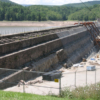Overview
Underground near Cigar Lake in Northern Saskatchewan, Canada, lies the worlds 2nd richest deposit of Uranium. It is the worlds largest deposit of undeveloped Uranium. The mine is being developed by a jointventure majority owned by Cameco Corporation, headquartered in Saskatoon, Saskatchewan. Cameco Corporation is the world’s largest uranium producer, currently producing uranium from the worlds richest deposit in nearby McArthur River. The company’s uranium products are used to generate electricity in nuclear energy plants around the world, providing one of the cleanest sources of energy available today.
The Cigar Lake ore body is located approximately 430 meters below surface and is approximately 2150 meters long with a width that ranges from 20 meters to 100 meters. Its height ranges from about 6 meters to 15 meters. Recovery of the ore presents significant technical challenges, not the least of which is its location underground in poor quality rock near a substantial body of water and its high radioactivity. Extensive testing for over a decade was required to select and validate “jet boring” as the ore recovery method. Jet boring at Cigar Lake requires several major efforts: Tunnel Boring Machine (TBM) development below the ore body to provide access, installation of “freeze holes” through the ore body and surrounding rock, development of a freeze plant to produce the brine needed to artificially freeze the ore body and surrounding rock, installation of cased pilot holes upwards through the ore and finally, ore extraction using a rotating high pressure water jet inserted in the pilot holes. The ore will be ground with water to form slurry and then pumped to the surface. It will then be placed in specially designed containers to be transported by truck to the processing mill. After ore extraction the ore cavities will be backfilled with concrete. A schematic depiction of the sequence required for the jet boring extraction method to be used at Cigar Lake is shown at right.
Production & Monitoring
At full production during phase 1, Cigar Lake will produce 18 million pounds of yellowcake (U3O8) annually. The eastern Phase 1 U3O8 reserves are estimated to be 232 million pounds at an average grade of 21%. The western lower grade Phase 2 U3O8 reserves are estimated to be 118 million pounds at an average grade of 16.9%. The mine will have a life span of about 30 to 40 years and employ more than 200 people.
Several instrumentation and monitoring programs have been implemented in the course of developing the mine. These include instrumentation to measure the ground freeze pressures on the tunnel linings and optimize concrete segment design specifications and instrumentation to monitor mine safety in critical cross-cuts.
What We Did
Numerous concrete segments which comprise the tunnel lining have been instrumented with Geokon Vibrating Wire Embedment Strain Gages and Vibrating Wire Radial and Circumferential Pressure Cells. This instrumentation is designed to estimate the field stresses induced due to freezing so as to provide comparison to the modeled stresses. Numerous Geokon Vibrating Wire Multiple-Position Borehole Extensometers (MPBX’s) have also been installed in critical drifts and cross-cuts to provide information for mine safety evaluations.
Our Services
We have provided the following products and services for this installation:
- Services related to commissioning of the datalogging systems. This has included retro-fitting the systems with our VWDSP Interface to provide higher quality vibrating wire measurements. This has also included extensive troubleshooting of the systems due to the numerous challenges of the underground installation including electrical noise, water ingress and cable damage due to mine operations. • Services related to commissioning and troubleshooting of the communications network that connects the monitoring systems underground via fiber-optic cables to the above-ground monitoring computers.
- Supply and installation of our MultiLoggerDB software to manage all the instrumentation data and provide alarm monitoring and automated report and chart generation. This includes use of our Insite software to provide various mine personnel with current measurements and all pre-configured reports and charts of the instrumentation data. A view of the project database including one of the instrumented tunnel segments is shown.
- Training in the use and management of the systems and our MultiLoggerDB and Insite software so mine personnel can provide for new instrumentation and functionality as the monitoring system is expanded.


